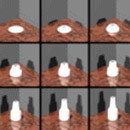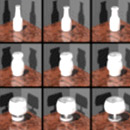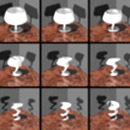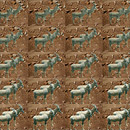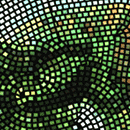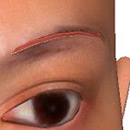This sequence of three images contains samples of a small animation created by a metamorphosis process of freeform NURBs surfaces.
Image metamorphosis as an animation tool has mostly been employed in the context of the entire image. This work explores the use of isolated and focused image based metamorphosis between two-dimensional objects, while capturing the features, colors, and textures of the objects. This pinpointed approach allows one to independently overlay several such dynamic shapes, without any bleeding of one shape into another. Hence, shape blending and metamorphosis of two-dimensional objects can be exploited as animated sequences of clip arts.
The image on the left shows a morphing sequence of two gazelles to two topis. Note the constant background in the image throughout the morphing sequence. A joint work with the EE department, Technion.
This work discusses the principles of traditional mosaics, and describes a technique for implementing a digital mosaicing system. The goal of this work is to transform digital images into traditional mosaic-like renderings. We achieve this effect by recovering freeform feature curves from the image and laying rows of tiles along these curves. Composition rules are applied to merge these tiles into an intricate jigsaw that conforms to classical mosaic styles. Mosaic rendering offers the user flexibility over every aspect of this craft, including tile arrangement, shapes, and colors. The result is a system that makes this wonderful craft more flexible and widely accessible than previously possible.
Surgical simulation with the aid of computers is a topic of increasingly extensive research. Real-time response and interactivity are crucial components of any such system and a major effort has been invested in finding ways to improve the performance of existing systems. In this work, we propose the use of a new variant of Free Form Deformations that supports discontinuities (DFFD) in complex real time surgical simulations. The proposed scheme can benefit from an a priori or, alternatively, interactive low resolution, physical simulation of the incision procedure that is encoded into the DFFD. The DFFD is then applied to the geometry of the tissue in hand, a two-dimensional skin shape or a three-dimensional volumetric representation, capturing the incision's shape as well as the behavior of the neighborhood geometry over time.
